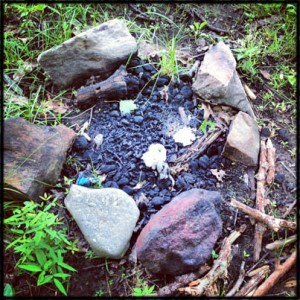Everything you need to know about geocaching in Harriman State Park, NY.
What is Geocaching?
Geocaching in Harriman State Park can lead you to places of interest within the park that you might not have gone otherwise. You’ll use your hand-held GPS device — an iphone or Android phone works fine — to plug in coordinates to find “caches,” or hidden containers filled with treasures*. Harriman contains at more than one hundred caches. Some are active, some have been abandoned by their owners but are still in their original spots and are, technically, “active”.

Treasure, or just a lot of trash? It doesn’t matter: geocaching in Harriman can lead you to discover places you might not otherwise. ©www.myharriman.com
To find the coordinates of these caches and for all other information, consult the official geocaching website and type in the name of the park or geocaching locations you are interested in visiting.
Placing Your Own Cache for Geocaching in Harriman
If you’d like to place your own cache in Harriman State Park, you’ll have to apply for a permit from the New York State Office of Parks, Recreation and Historic Preservation.
Here’s the application for the permit for placements and maintenance of your geocache:
Download the GeoCache Application And Permit Form Here.
You can also pick up a permit in person (8:30-4:30 Monday-Friday) from the park office closest to where the cache will be hidden. There are offices at Bear Mountain, Lake Tiorati and Lake Welch.
Conditions (You knew there were conditions, right?):
- A cache owner is limited to a maximum of five (5) permits in one facility at one time
- Multi-caches leave clues to find the next site, eventually leading to a cache. Multi-caches will be limited to a total of five (5) sites, but require only one permit. However, since the potential use or impacts of each site is the same, no more than five (5) sites per cache owner will be permitted in one facility at one time. For instance, if a multi-cache consists of 5 sites, the cache owner will only be allowed one permit at a time.
- Caches will not be permitted within 1320 feet (1/4 mile) of an existing permitted cache
- All permits will be valid for two (2) years. Exact starting and ending dates will be recorded on the permit.
- If, during the effective period of a permit, the holder wishes to change the location of the cache, a new permit must be issued and the effective permit cancelled.
- Upon permit expiration, the owner is responsible for removing the cache and removing its location from the website or other information source as an active cache.
- Once the cache is placed, a description of the cache and its location indicated on a park map, as well as the GPS coordinates, must be given to the facility manager or designee for completion of the permit.
- Owner must monitor the cache twice a year to maintain family-friendly contents.
- Caches are subject to removal by the facility manager or designee if:
Facility staff determines that the location of the cache poses a risk to visitors. A new permit may be generated for the relocation of such a cache.
Facility staff determines that the cache has been the cause of an adverse environmental impact. The permit for such a cache will be cancelled.
Facility staff discovers a non-permitted cache, or a cache that does not exhibit a permit number on the outside of the container.
If the facility manager or designee removes a cache, he or she will attempt to notify the owner or indicate on the website that the cache has been removed. The cache will be retained at the park office for 30 days. If the owner cannot be contacted after that time, the cache is considered abandoned property and may be retained in the event the owner comes to claim it at a later date. Justification for removal of a cache will be recorded on the permit.
Cache Placement:
- The facility manager or designee will inform the applicant of areas recognized as off limits to geocache placement.
- The cache should be accessible from existing trails (no more than twenty (20) feet from trail unless otherwise approved).
- Caches are not to be placed on or in:
Locations that would lead to or create spur trails
Sensitive archaeological, historical, or ecological areas, e.g. wetlands, caves, historical buildings, locations containing rare plant or animal species, stream banks, and dam structures.
Prescribed burn areas scheduled to be burned within 12 months of the permit request.
Areas that could potentially cause danger to visitors trying to locate the cache, such as, elevated in trees, underwater or in potential flood areas, places requiring climbing cliffs or bluffs.
Any State Park structure or State Historic Site structure.
- Burying caches is strictly prohibited.
Life of a Cache
- A cache may be located at a site for a maximum of 2 years.
- After 2 years, the owner will be responsible for retiring or relocating the cache.
Cache Container
- Cache containers must display an official, park issued geocache label on the outside of the container with the permit number and expiration date.
- Cache must not contain food, alcohol, drugs, medications, dangerous items, adult items, or weapons of any kind.
- Container should be watertight and non-breakable, and have a latch or closing mechanism to prevent exposure to wildlife.
- The container should not be larger than 1,000 cu. in. unless authorized by the facility manager.
Geocaching in Harriman State Park? Follow these rules:
- Participants must follow established trails (no bushwhacking to reach a cache).
- Participants must leave the caches where they found them.
- Participants must not use metal detectors in cache searches.
All caches are subject to random inspection by the facility managers or their designees, who have the authority to remove any item deemed unacceptable.
*usually cheap plastic stuff. :0)


